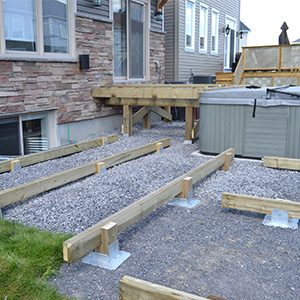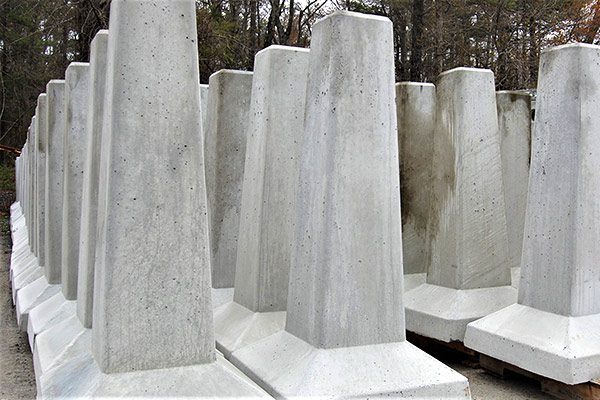Picking the Right Deck Footings for Security and Longevity
The long life and security of your deck depend greatly on the type of footings you pick, as they provide the necessary support and stability to hold up against the test of time. In this discussion, we will certainly discover the various kinds of deck grounds, consider the essential aspects to consider when making a decision, and dig right into the pros and disadvantages of various options.
Sorts Of Deck Grounds
These footings are composed of a round hole filled with concrete, which provides a solid foundation for the deck posts. Concrete pier footings are fairly easy to install and offer outstanding stability, making them a prominent choice for lots of deck tasks.
One more kind of footing is the helical stack ground. Helical stacks are steel shafts with helical plates attached to them. These footings are installed by screwing them into the ground, which develops a safe and secure structure for the deck. Helical stack footings are perfect for areas with challenging soil problems, as they can be set up in practically any type of kind of soil. They likewise allow for easy change and progressing of the deck if needed.
Additionally, some builders select precast concrete footings. These grounds are made from durable concrete and come in numerous shapes and dimensions to fit different deck layouts. Precast concrete footings are convenient to mount and offer a stable base for the deck structure.
Ultimately, an additional choice is the post-in-anchor ground system. This kind of footing includes driving a metal support into the ground and affixing it to the deck message. It supplies flexibility in regards to positioning the deck posts and appropriates for decks with lightweight structures.
When picking the best type of deck ground, it is necessary to consider elements such as dirt conditions, deck tons, and local building ordinance (Deck Footings). Consulting with a professional contractor or structural designer can help make sure the appropriate footing is selected for a secure and steady deck
Aspects to Take Into Consideration When Choosing Footings
When selecting the suitable grounds for a deck, it is essential to very carefully take into consideration numerous elements such as soil problems, deck lots, and adherence to neighborhood building ordinance. These aspects play a significant function in making sure the security and durability of the deck structure.
Among the key factors to consider is the soil conditions. The type of soil on which the deck will certainly be constructed establishes the kind of footings required. Decks developed on sandy or loosened dirts might need deeper footings to supply ample assistance and protect against settling. On the various other hand, decks constructed on clay or extensive soils may require footings that can suit the dirt's tendency to expand and contract.
One more essential element is the deck tons. The weight of the deck, consisting of the products utilized and any possible online loads such as furnishings or events, must be thought about when choosing footings. The grounds must be made to birth the weight of the deck and distribute it equally to stop any architectural issues or failings.
Finally, adherence to local structure codes is critical. Building regulations vary from area to region, and it is important to follow the particular demands established by the regional authorities. Deck Footings. These codes guarantee that the deck is constructed safely and fulfills the needed requirements for architectural integrity and load-bearing ability
Concrete Footings: Pros and Disadvantages

When utilized as the structure for a deck,Concrete grounds provide numerous advantages and drawbacks. On the silver lining, concrete grounds give outstanding security and sturdiness. Concrete is a inflexible and strong material that can support hefty loads and endure different climate condition. It additionally has a long life expectancy, making it a reliable choice for long-term use.
One more advantage of concrete footings is their versatility. They can be put right into various sizes and shapes to accommodate various deck designs and configurations. Concrete footings can be customized to fit the details requirements and demands of the deck framework.
However, there are also some downsides to utilizing concrete footings. This can raise the overall price of the deck job and may call for expert assistance.

Helical Piers Vs. Sonotubes: Which Is Better?
In thinking about the structure options for a deck, the contrast between helical piers and sonotubes is important in identifying the exceptional choice. They are twisted right into the visit here ground making use of hydraulic machinery, web offering a stable and sturdy foundation for the deck.
When it comes to security and toughness, helical piers have the upper hand. The helical plates on the piers create a solid grip with the dirt, shifting or protecting against any type of movement of the deck. This is specifically helpful in areas with unpredictable or moving soil conditions. Sonotubes, on the various other hand, rely only on the concrete filling up for security, which may not supply the very same degree of strength and resistance.
In regards to installment, helical piers are fairly less complicated and faster to install contrasted to sonotubes. The hydraulic equipment made use of to twist the piers into the ground makes certain a reliable and quick procedure. Sonotubes, on the other hand, call for excavating holes and pouring concrete, which can be taxing and labor-intensive.
In addition, helical piers are an even more flexible option. If required, they can be made use of in various soil problems and can be readjusted or strengthened. Sonotubes, on the various other hand, might call for additional support, such as rebar, in certain soil problems or locations with high lots needs.
Picking the Right Footings for Your Deck's Dimensions
For ideal architectural stability, it is necessary to thoroughly choose the ideal grounds that straighten with the dimensions of your deck. The dimensions of your deck, including its elevation, size, and size, play a substantial duty in figuring out the kind and dimension of footings needed.
When choosing footings for your deck, it is very important to consider the load-bearing capacity of the dirt. The weight of the deck, incorporated with the weight of any kind of furnishings or individuals on it, puts in a significant force on the footings visit their website (Deck Footings). It is essential to choose grounds that can effectively sustain this weight without sinking or shifting over time.
The shapes and size of the footings need to likewise be thought about. Bigger decks with higher dimensions require bigger footings to give enough security and assistance. The shape of the grounds, whether they are round or square, relies on the style and format of the deck. Furthermore, the depth at which the grounds are set up should be established based on the frost line in your region to stop any type of heaving or changing because of freezing temperatures.
Final Thought
In verdict, picking the right deck footings is important for making certain security and durability. Variables such as the type of footings, the deck's dimensions, and the pros and cons of various alternatives must be thought about.
These grounds consist of a cylindrical hole filled with concrete, which supplies a strong structure for the deck blog posts. Concrete pier grounds are reasonably very easy to mount and use outstanding security, making them a preferred selection for several deck tasks.
Precast concrete grounds are practical to mount and give a secure base for the deck framework.
It uses versatility in terms of positioning the deck messages and is suitable for decks with lightweight structures.
Concrete grounds supply numerous advantages and downsides when used as the foundation for a deck.
Comments on “A Solid Structure for Your Sanctuary: Exploring the Value of Deck Footings in Outdoor Frameworks”